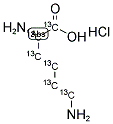L-Lysine-1,2,3,4,5,6(hydrochloride (1:1))-13C6
Modify Date: 2025-08-24 22:11:53

L-Lysine-1,2,3,4,5,6(hydrochloride (1:1))-13C6 structure
|
Common Name | L-Lysine-1,2,3,4,5,6(hydrochloride (1:1))-13C6 | ||
|---|---|---|---|---|
| CAS Number | 1228077-86-8 | Molecular Weight | 188.7 | |
| Density | N/A | Boiling Point | N/A | |
| Molecular Formula | C6H15ClN2O2 | Melting Point | 263-264 °C (dec.) (lit.) | |
| MSDS | N/A | Flash Point | N/A | |
Use of L-Lysine-1,2,3,4,5,6(hydrochloride (1:1))-13C6L-Lysine-1,2,3,4,5,6(hydrochloride (1:1))-13C6 is the 13C labeled L-Lysine hydrochloride[1]. L-lysine hydrochloride is an essential amino acid for humans with various benefits including treating herpes, increasing calcium absorption, reducing diabetes-related illnesses and improving gut health[2][3][4]. |
| Name | l-lysine-13c6 hydrochloride |
|---|
| Description | L-Lysine-1,2,3,4,5,6(hydrochloride (1:1))-13C6 is the 13C labeled L-Lysine hydrochloride[1]. L-lysine hydrochloride is an essential amino acid for humans with various benefits including treating herpes, increasing calcium absorption, reducing diabetes-related illnesses and improving gut health[2][3][4]. |
|---|---|
| In Vitro | Stable heavy isotopes of hydrogen, carbon, and other elements have been incorporated into drug molecules, largely as tracers for quantitation during the drug development process. Deuteration has gained attention because of its potential to affect the pharmacokinetic and metabolic profiles of drugs[1]. |
| References |
| Melting Point | 263-264 °C (dec.) (lit.) |
|---|---|
| Molecular Formula | C6H15ClN2O2 |
| Molecular Weight | 188.7 |
| InChIKey | BVHLGVCQOALMSV-BOBMYJBMSA-N |
| SMILES | Cl.NCCCCC(N)C(=O)O |
| WGK Germany | 3 |
|---|